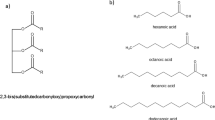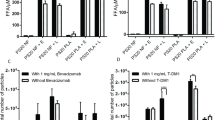Abstract
Development of lipid oxidation in casein-stabilized emulsion-gels prepared using microbial transglutaminase was investigated. The oxidative stability of emulsion-gels was assessed based on measurement of the amount of lipid hydroperoxide, hexanal, and 1-octen-3-ol. Profiles of lipid hydroperoxide showed that formation of lipid hydroperoxide was reduced in emulsion-gels, compared with emulsions, regardless of the storage temperature. Quantitative analysis of hexanal and 1-octen-3-ol showed no significant (p>0.05) difference between oxidative stabilities of emulsion-gels and emulsions. The storage temperature did not affect formation patterns of hydroperoxide, hexanal, and 1-octen-3-ol. Transglutaminase can be a useful tool for retardation of lipid oxidation based on formation of emulsion-gels.
Similar content being viewed by others
References
McClements DJ, Decker EA. Lipid oxidation in oil-in-water emulsions: Impact of molecular environment on chemical reactions in heterogeneous food systems. J. Food Sci. 65: 1270–1282 (2000)
Halliwell B, Murcia MA, Chirico S, Aruoma OI. Free radicals and antioxidants in food and in vivo: What they do and how they work. Crit. Rev. Food Sci. 35: 7–20 (1995)
Watkins SM, German JB. Unsaturated fatty acids. pp. 513–537. In: Food Lipids: Chemistry, Nutrtion, and Biotechnology, 3rd ed. Akoh CC, Min DB (eds). CRC Press, Boca Raton, FL, USA (2008)
McClements DJ. Context and background. pp. 1–26. In: Food Emulsions: Principles, Practice, and Techniques. 2nd ed. McClements DJ. CRC Press, Inc., Boca Raton, FL, USA (2005)
Fritsch CW. Lipid oxidation-the other dimensions. Inform 5: 426–436 (1994)
Mancuso JR, McClements DJ, Decker EA. The effects of surfactant type, pH, and chelators on the oxidation of salmon oil-in-water emulsions. J. Agr. Food Chem. 47: 4112–4116 (1999)
Frankel EN, Huang S-W, Kanner J, German JB. Interfacial phenomena in the evaluation of antioxidants: Bulk oils vs emulsions. J. Agr. Food Chem. 42: 1054–1059 (1994)
Tang C-H, Chen L, Foegeding EA. Mechanical and water-holding properties and microstructures of soy protein isolate emulsion gels induced by CaCl2, glucono-d-lactone (GDL), and transglutaminase: Influence of thermal treatments before and/or after emulsification. J. Agr. Food Chem. 59: 4071–4077 (2011)
Lee HA, Choi SJ, Moon TW. Characteristics of sodium caseinate-and soy protein isolate-stabilized emulsion-gels formed by microbial transglutaminase. J. Food Sci. 71: C352-C357 (2006)
Yang M, Liu F, Tang C-H. Properties and microstructure of transglutaminaseset soy protein-stabilized emulsion gels. Food Res. Int. 52: 409–418 (2013)
Ando H, Adachi M, Umeda K, Matsuura A, Nonaka M, Uchio R, Tanaka H, Motoki M. Purification and characteristics of a novel transglutaminase derived from microoganisms. Agr. Biol. Chem.Tokyo 53: 2613–2617 (1989)
Bradford MM. A rapid and sensitive method for the quantitation of microgram quantities of protein utilizing the principle of protein-dye binding. Anal. Biochem. 72: 248–254 (1976)
Dickinson E, Rolfe SE, Dalgleish DG. Competitive adsorption of as1-casein and ß-casein in oil-in-water emulsions. Food Hydrocolloid. 2: 397–405 (1988)
Nio N, Motoki M, Takinami K. Gelation mechanism of protein solution by transglutaminase. Agr. Biol. Chem.Tokyo 50: 851–855 (1976)
Nuchi CD, McClements DJ, Decker EA. Impact of Tween 20 hydroperoxides and iron on the oxidation of methyl linoleate and salmon oil dispersions. J. Agr. Food Chem. 49: 4912–4916 (2001)
Dickinson E, Hong S-T. Surface coverage of ß-lactoglobulin at the oil-water interface: Influence of protein heat treatment and various emulsifiers. J. Agr. Food Chem. 42: 1602–1606 (1994)
Coupland JN, McClements DJ. Lipid oxidation in food emulsions. Trends Food Sci. Tech. 7: 83–91 (1996)
Abdalla AE, Roozen JP. Effect of plant extracts on the oxidative stability of sunflower oil and emulsion. Food Chem. 64: 323–329 (1999)
Forss DA. Odor and flavor compounds from lipids. Prog. Chem. Fats Other Lipids 13: 177–258 (1973)
Author information
Authors and Affiliations
Corresponding author
Rights and permissions
About this article
Cite this article
Lim, S.H., Kim, H.R., Choi, S.J. et al. Lipid oxidation of sodium caseinate-stabilized emulsion-gels prepared using microbial transglutaminase. Food Sci Biotechnol 24, 2023–2026 (2015). https://doi.org/10.1007/s10068-015-0267-9
Received:
Revised:
Accepted:
Published:
Issue Date:
DOI: https://doi.org/10.1007/s10068-015-0267-9




